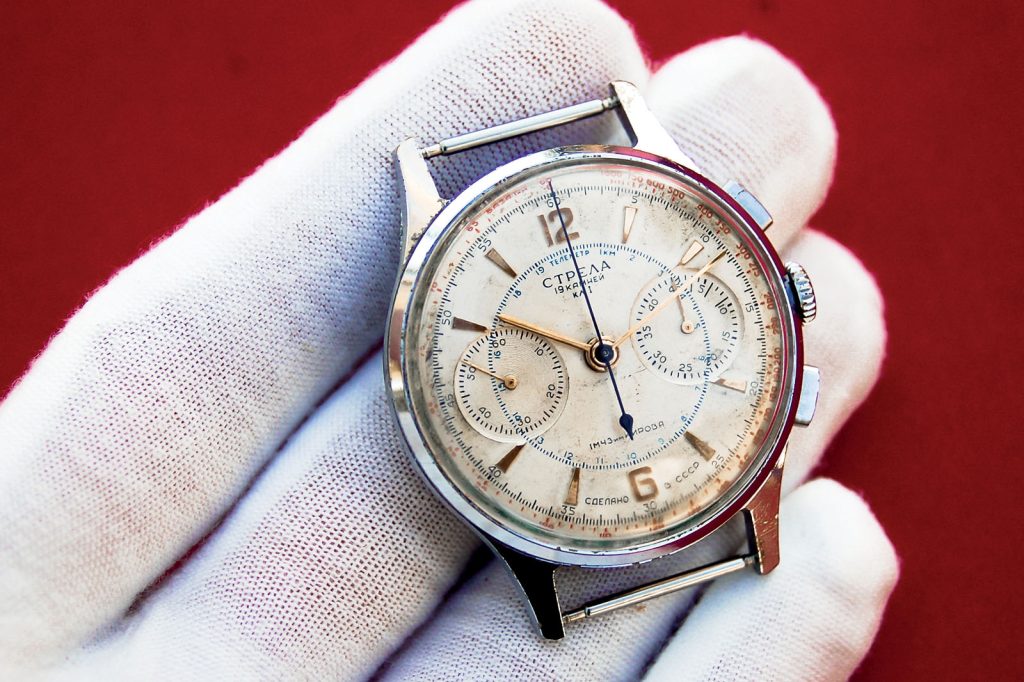Cultural Fusion: Strela Watches and Tech Titans’ “Anti-Luxury” Statement
In the heart of Silicon Valley, where innovation often goes hand in hand with ostentation, an unexpected trend has emerged: a fascination with vintage Soviet space watches, particularly the iconic Strela chronographs. Far from the usual luxury brands flaunted on wrists in the tech elite’s circles, these rugged, utilitarian timepieces have quietly ascended as a symbol of an alternative ethos—one that rebels against traditional luxury’s excess and embraces a minimalist, almost ideological, form of status.
The Strela, originally manufactured during the Soviet era and famously worn by cosmonauts like Alexei Leonov on early space missions, carries a legacy steeped in Cold War history and scientific ambition. Silicon Valley’s tech leaders, known for their subtle fashion cues and ironic detachment from ostentatious branding, have latched onto the Strela as a statement of “anti-luxury.” Unlike ostentatious Swiss watches loaded with precious metals or high-tech complications, the Strela’s modest design and mechanical honesty embody a stripped-down, purpose-driven mentality that resonates deeply with tech culture’s values of functionality, innovation, and disruption.
In a way, wearing a Strela has become a quiet declaration: “I reject conventional luxury’s flashiness and instead align myself with innovation born out of necessity and resilience.” This cultural fusion is more than nostalgia—it’s a reclamation of a forgotten industrial artifact turned into a symbol of authenticity. As Silicon Valley’s visionaries champion sustainability, open source, and DIY ethics, the Soviet space watch stands as a paradoxical yet fitting badge of honor, blending vintage heritage with cutting-edge cultural capital.
Market Surge: eBay Prices Rocket 700% in Three Months
What began as a niche fascination has rapidly evolved into a full-blown market phenomenon. Over the past three months, Strela watches have experienced an unprecedented price surge on secondary markets, particularly eBay, where listings soared by an astonishing 700%. This explosive growth reflects both scarcity and a newfound global demand driven primarily by Silicon Valley influencers, collectors, and watch enthusiasts who recognize the Strela’s historical significance and cultural cachet.
Several factors have fueled this dramatic market shift. First, the watches themselves are rare relics from a bygone era, with original models from the 1950s and 60s being increasingly difficult to find in good condition. Second, savvy buyers have noticed the Strela’s newfound association with the tech elite, transforming it from an obscure Soviet artifact into a coveted status symbol with a compelling narrative. Lastly, limited releases and modern reissues from boutique manufacturers replicating the original designs have intensified interest and competition.
The market frenzy has also spurred a secondary ecosystem of restoration experts, vintage dealers, and even watchmakers specializing in Soviet-era calibers. Prices for well-preserved models, especially those with verifiable provenance or ties to cosmonaut history, have reached six figures at auction, a staggering leap from prices just a year prior. The Strela’s rise is a testament to how storytelling, cultural identity, and exclusivity can reshape value in the collector’s market—sometimes overnight.

Modification Guide: Legal Ways to Preserve Communist Symbols
For many enthusiasts, part of the Strela’s appeal lies in its unabashed Soviet iconography—red stars, Cyrillic script, hammer-and-sickle insignias—that evoke the era’s complex historical narrative. However, for collectors in Western countries, wearing these symbols openly can be fraught with legal and social challenges. Some jurisdictions have strict laws prohibiting the display of communist symbols, while others regard them as politically sensitive.
To navigate these constraints while honoring the watch’s authentic design, a growing number of modification specialists have developed “legalized preservation” techniques. These modifications balance respect for historical aesthetics with compliance to local regulations. For example, certain aftermarket services offer reversible dial replacements that obscure prohibited symbols without permanently altering the watch, allowing collectors to switch between “public” and “private” modes depending on context.
Others have turned to micro-engraving and subtle dial overlays that render the Soviet insignia in abstract or minimalist designs, preserving the essence without explicit imagery. Some collectors even commission custom-made NATO straps and cases that partially cover symbols, creating a layered effect that invites insider recognition without provoking controversy.
These approaches have become part of the broader collector culture around Soviet watches, emphasizing education, historical appreciation, and creative problem-solving. They allow wearers to display their passion for Cold War horology and its countercultural significance while respecting modern legal frameworks and social sensitivities.
The Strela’s Place in Silicon Valley’s Culture and Beyond
The meteoric rise of the Strela watch within Silicon Valley’s elite circles is more than a passing fad; it represents a profound cultural shift. In an industry often critiqued for material excess and superficial branding, the embrace of a Soviet-era timepiece speaks to a desire for authenticity, intellectual irony, and connection to a storied past of scientific achievement under adversity.
Furthermore, this trend illustrates how objects once dismissed as relics of a closed-off regime can be recontextualized into global symbols of innovation and identity. The Strela is no longer just a chronograph; it’s a conversation starter, a symbol of resilience, and an emblem of a new kind of luxury—one defined not by price tags but by narrative depth and cultural resonance.
As the market continues to evolve, collectors and enthusiasts will likely see further innovation in how these watches are preserved, modified, and celebrated. Whether through bespoke customizations, new vintage-inspired models, or expanded cultural discourse, the Soviet space watch’s legacy is firmly established in the modern zeitgeist.
For those looking to join this movement, the journey begins not just with acquisition but with appreciation—understanding the watch’s history, its symbolism, and its unexpected role as a status symbol in one of the world’s most forward-looking communities.









































